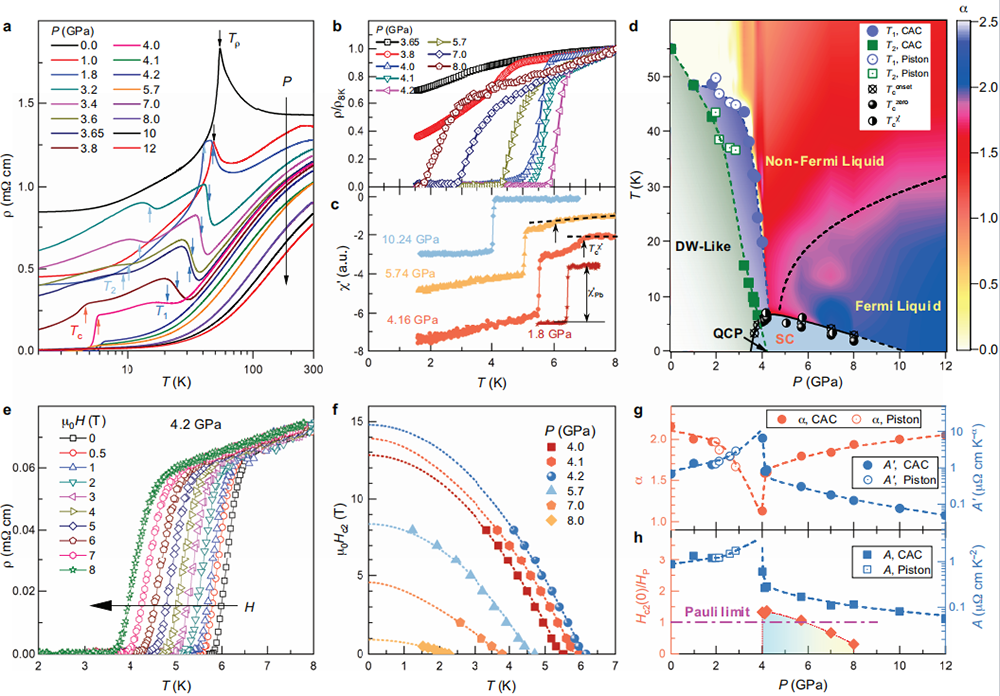Discovery of a New Chromium-Based Kagome Superconductor---The key roles of SECUF
Date:29-08-2024 Print
Quantum materials with kagome-type structures have been receiving a lot of attention due to the presence of unique features such as flat bands, Dirac points, and Van Hove singularities in their band structures. Recently, a family of vanadium-based kagome metals AV3Sb5 (A = K, Rb, Cs) that were synthesized experimentally has been the focus of extensive investigations because of the observations of many intriguing properties, including superconductivity, chiral charge order, pairing density wave, and anomalous Hall effect. Nevertheless, this class of materials are most likely phonon-mediated conventional superconductors, in line with the nonmagnetic nature and relatively weak electron correlations. Whether superconductivity can be observed in electron-correlated magnetic kagome materials is of great significance within the realm of kagome superconductivity.
Recently, Prof. CAO Guanghan's team from Zhejiang University synthesized a brand-new chromium-based kagome material, CsCr3Sb5, which exhibits both strong electron correlations and long-range magnetic order. Collaborating with Prof. CHENG Jinguang's team and Prof. ZHOU Rui's team from the Institute of Physics, Chinese Academy of Sciences, they utilized the unique experimental techniques at Synergetic Extreme Condition User Facility (SECUF) to successfully observe unconventional superconductivity in CsCr3Sb5 near its magnetic quantum critical point driven by pressure.
The researchers utilized the high-field nuclear magnetic resonance (NMR) system at the SECUF-A6 experimental station to probe the magnetic order via a prolonged measurement on tiny samples (0.1 mg). The 123Sb-NMR spectrum at a strong magnetic field of 25 T revealed a significant decrease in spectral weight as the temperature decreased below TN≈55K. The observed splitting of the 123Sb-NMR spectrum into two broad peaks at lower temperatures, Figure 1, provides direct spectroscopic evidence for the existence of antiferromagnetic order, which underscores CsCr3Sb5 as a strongly correlated antiferromagnetic metal.
The researchers then performed comprehensive resistivity and ac magnetic susceptibility measurements on the CsCr3Sb5 single crystals at the SECUF-A2 experimental station by using the large-volume cubic anvil cell high-pressure and low-temperature property measurement system. As pressure increased, the antiferromagnetic order at ambient pressure gradually transformed into two continuous transitions, with the density wave transition being suppressed (Fig. 2). The emergence of bulk superconductivity at a pressure of approximately 3.65GPa was confirmed by the observation of zero resistivity and obvious diamagnetic signals. In the pressure range of 3.65 - 8GPa, the superconducting transition temperature 𝑇c forms a dome shape as a function of pressure. Notably, the magnetic order is completely suppressed at the critical pressure Pc ≅ 4.2GPa, where the highest superconducting transition temperature Tc = 6.4K is reached and non-Fermi liquid behavior is observed. The T-P phase diagram of CsCr3Sb5 resembles that of unconventional superconductors such as Fe-based superconductors, CrAs, and MnP. These results suggest that pressure-induced superconducting state in CsCr3Sb5 likely involves an unconventional pairing mechanism, which provides a new material platform for studying strong-coupling physics in kagome lattice.
This study entitled “Superconductivity under pressure in a chromium-based kagome metal” was published on Nature.
The study was supported by the National Key R&D Program of China, the National Science Foundation, the Key R&D Program of Zhejiang Province, China, the Strategic Priority Research Program of CAS, and the outstanding Member of Youth Promotion Association of CAS. The all- superconducting magnet of the SECUF-A6 experimental station was co-developed by the team led by Prof. Qiuliang Wang at the Institute of Electrical Engineering, Chinese Academy of Sciences.

Fig.1 High-field nuclear magnetic resonance measurements on CsCr3Sb5 single crystals and the observation of antiferromagnetic order. (Image by Institute of Physics)

Fig.2 Unconventional superconductivity induced by high pressures in CsCr3Sb5. (Image by Institute of Physics)
Contact:
Institute of Physics
CHENG Jinguang Email:jgcheng@iphy.ac.cn
ZHOU Rui Email: rzhou@iphy.ac.cn
Key words:
magnetic kagome metal; unconventional superconductor; high pressure; SECUF
Abstract:
Researchers have discovered a chromium-based kagome metal, CsCr3Sb5, exhibiting strong electron correlations, frustrated magnetism, and characteristic flat bands near the Fermi level. The unique experimental techniques in SECUF play a crucial role in investigating the physical properties of this novel unconventional superconductor.

